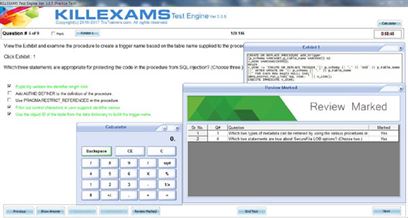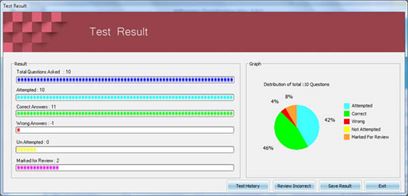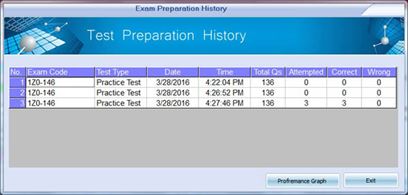Ophthalmic Coding Specialist Exam Braindumps
Killexams.com OCS Exam Braindumps contain complete question pool, updated in April 2024 including VCE exam simulator that will help you get high marks in the exam. All these OCS exam questions are verified by killexams certified professionals and backed by 100% money back guarantee.
OCS basics - Ophthalmic Coding Specialist Updated: 2024 | ||||||||
| Take a review at these OCS dumps question and answers | ||||||||
 |
||||||||
|
||||||||
|
Exam Code: OCS Ophthalmic Coding Specialist basics January 2024 by Killexams.com team | ||||||||
OCS Ophthalmic Coding Specialist Test Detail: The OCS (Ophthalmic Coding Specialist) exam is conducted to certify individuals who possess the knowledge and skills required to accurately assign medical codes for ophthalmic procedures and services. The exam evaluates the candidate's understanding of coding guidelines, reimbursement policies, and ophthalmic terminology. Course Outline: The course for the OCS certification covers various syllabus related to ophthalmic coding. The following is a general outline of the key areas covered: 1. Introduction to Ophthalmic Coding: - Overview of the role of an Ophthalmic Coding Specialist. - Understanding the purpose and importance of accurate medical coding. - Familiarization with coding systems and guidelines specific to ophthalmology, such as CPT, ICD-10, and HCPCS. 2. Ophthalmic Terminology and Anatomy: - Understanding ophthalmic anatomy and physiology. - Learning common ophthalmic conditions and diseases. - Familiarization with ophthalmic terminology and abbreviations. 3. Coding Guidelines and Documentation: - Understanding coding guidelines and conventions. - Reviewing documentation requirements for ophthalmic procedures and services. - Identifying key elements necessary for accurate coding and reimbursement. 4. Ophthalmic Coding Systems: - Understanding the Current Procedural Terminology (CPT) coding system. - Familiarization with the International Classification of Diseases (ICD) coding system. - Learning the Healthcare Common Procedure Coding System (HCPCS). 5. Evaluation and Management (E/M) Services: - Understanding the E/M coding guidelines specific to ophthalmology. - Identifying the key components of E/M services and assigning appropriate codes. - Reviewing documentation requirements for E/M services. 6. Surgical Procedures and Services: - Coding for common ophthalmic surgical procedures, such as cataract surgery, corneal transplant, and glaucoma procedures. - Understanding modifiers and their application in ophthalmic coding. - Familiarization with surgical documentation requirements. 7. Diagnostic Testing and Imaging: - Coding for ophthalmic diagnostic tests and imaging procedures, including visual field tests, optical coherence tomography (OCT), and fundus photography. - Familiarization with coding guidelines and documentation requirements for diagnostic testing. Exam Objectives: The OCS exam focuses on evaluating the candidate's knowledge and understanding of the following key areas: 1. Ophthalmic Coding Guidelines and Conventions 2. Ophthalmic Terminology and Anatomy 3. Evaluation and Management (E/M) Services Coding 4. Surgical Procedures and Services Coding 5. Diagnostic Testing and Imaging Coding 6. Reimbursement Policies and Regulations Exam Syllabus: The exam syllabus for the OCS certification provides a detailed breakdown of the syllabus covered in each exam objective. It includes sub-topics, coding scenarios, and specific coding guidelines that candidates should be familiar with. The syllabus may cover the following areas: - Ophthalmic surgical procedures and coding - Ophthalmic diagnostic testing and imaging procedures - Evaluation and management (E/M) coding in ophthalmology - Coding guidelines and conventions specific to ophthalmology - Reimbursement policies and regulations for ophthalmic coding | ||||||||
| Ophthalmic Coding Specialist Medical Ophthalmic basics | ||||||||
Other Medical examsCRRN Certified Rehabilitation Registered NurseCCRN Critical Care Register Nurse CEN Certified Emergency Nurse CFRN Certified Flight Registered Nurse CGFNS Commission on Graduates of Foreign Nursing Schools CNA Certified Nurse Assistant CNN Certified Nephrology Nurse CNOR Certified Nurse Operating Room DANB Dental Assisting National Board Dietitian Dietitian EMT Emergency Medical Technician EPPP Examination for Professional Practice of Psychology FPGEE Foreign Pharmacy Graduate Equivalency NBCOT National Board for Certification of Occupational Therapists - 2023 NCBTMB National Certification Board for Therapeutic Massage & Bodywork NET Nurse Entrance Test NPTE National Physical Therapy Examination OCN Oncology Certified Nurse - 2023 PANCE Physician Assistant National Certifying VTNE Veterinary Technician National Examination (VTNE) CNS Clinical Nurse Specialist NBRC The National Board for Respiratory Care AHM-540 AHM Medical Management AACN-CMC Cardiac Medicine Subspecialty Certification AAMA-CMA AAMA Certified Medical Assistant ABEM-EMC ABEM Emergency Medicine Certificate ACNP AG - Acute Care Nurse Practitioner AEMT NREMT Advanced Emergency Medical Technician AHIMA-CCS Certified Coding Specialist (CPC) (ICD-10-CM) ANCC-CVNC ANCC (RN-BC) Cardiac-Vascular Nursing ANCC-MSN ANCC (RN-BC) Medical-Surgical Nursing ANP-BC ANCC Adult Nurse Practitioner APMLE Podiatry and Medical BCNS-CNS Board Certified Nutrition Specialis BMAT Biomedical Admissions Test CCN CNCB Certified Clinical Nutritionist CCP Certificate in Child Psychology CDCA-ADEX Dental Hygiene CDM Certified Dietary Manager CGRN ABCGN Certified Gastroenterology Registered Nurse CNSC NBNSC Certified Nutrition Support Clinician COMLEX-USA Osteopathic Physician CPM Certified Professional Midwife CRNE Canadian Registered Nurse Examination CVPM Certificate of Veterinary Practice Management DAT Dental Admission Test DHORT Discover Health Occupations Readiness Test DTR Dietetic Technician Registered FNS Fitness Nutrition Specialist MHAP MHA Phlebotomist MSNCB MSNCB Medical-Surgical Nursing Certification NAPLEX North American Pharmacist Licensure Examination NCCT-TSC NCCT Technician in Surgery NCMA-CMA Certified Medical Assistant NCPT National Certified Phlebotomy Technician (NCPT) NE-BC ANCC Nurse Executive Certification NNAAP-NA NNAAP Nurse Aide NREMT-NRP NREMT National Registered Paramedic NREMT-PTE NREMT Paramedic Trauma Exam OCS Ophthalmic Coding Specialist PANRE Physician Assistant National Recertifying Exam PCCN AACN Progressive Critical Care Nursing RDN Registered Dietitian VACC VACC Vascular Access WHNP Women Health Nurse Practitioner AACD American Academy of Cosmetic Dentistry RPFT Registered Pulmonary Function Technologist ACLS Advanced Cardiac Life Support - 2023 GP-Doctor General Practitioner (GP) Doctor GP-MCQS Prometric MCQS for general practitioner (GP) Doctor INBDE Integrated National Board Dental Examination (Day 1 exam) Podiatry-License-Exam-Part-III Podiatry License exam Part III - 2023 | ||||||||
| Looking for OCS dumps? You surely need to pass the OCS exam, but it can not heppen without valid and updated OCS dumps questions. You need to visit killexams.com for latest OCS dumps questions and vce exam simulator for practice. Then spend 10 to 20 hours on memorizing OCS real exam questions and practice with vce exam simulator using OCS braindumps files and you are ready to take real OCS test. | ||||||||
| Medical OCS Ophthalmic Coding Specialist https://killexams.com/pass4sure/exam-detail/OCS Question: 38 Which of the following is always the payer of last resort? A. Medicare B. Medicaid C. Workerís Compensation Insurance D. Commercial Insurance Answer: B Medicaid is always the payer of last resort. This means that if a patient has more than one type of insurance coverage, and one of the insurances is Medicaid, then the biller must bill the other insurance first and Medicaid second. Medicaid will never pay first, if the patient has more than one type of insurance coverage. Question: 39 HCPCS J-Codes are used to represent: A. Drugs administered by methods other than the oral method B. Durable medical equipment C. Dental procedures not found in the CPT manual D. Temporary national codes for Medicare Answer: A HCPCS J-Codes are used to represent drugs administered by methods other than the oral method. The J-codes are used to bill drugs administered to the patient, while in the office. Other sections in the HCPCS manual represent durable medical equipment and temporary national codes. Dental procedures are not represented at all in the CPT manual, and are reported with D-codes. Question: 40 What does HIPAA stand for? A. Health Insurance Portability and Accountability Act B. Health Insurance Protection and Accountability Association C. Health Insurance Post-Payment Auditing Association D. Health Insurance Accountability and Auditing Act Answer: A HIPAA stands for Health Insurance Portability and Accountability Act. HIPAA is an Act of Congress, not an association or organization. Those that do not follow HIPAA requirements can be prosecuted. HIPAA also joins with other organizations to ensure that everyone involved in patient healthcare follow its stipulations. Question: 41 Appendix 1 in the HCPCS Level II manual contains: A. An alphabetized list of HCPCS modifiers B. A table of drugs C. A list of changes, additions, and deletions D. A short list of CPT codes to use with HCPCS codes Answer: B Appendix A in the HCPCS Level II manual contains a table of drugs. This table lists all of the drugs in alphabetical order and can be found in the HCPCS manual. The listings are also organized according to the drugs administration route and unit information. Question: 42 In order for a physician to appropriately code for a consultation service, three things must be documented. What are those three things? A. The referral or request from the PCP, the rendering of the opinion by the specialist or consultant, and the written report or findings sent from the specialist to the PCP B. The rendering of the specialty service to the patient, the referral of the patient from the specialist to an additional specialist, and the written report of the findings provided to the specialist C. The specialist request of a second opinion regarding the patient, the PCPís advice regarding which second specialist the patient should see, and the second specialistís report or findings D. The referral from the PCP to the specialist, an additional referral from the specialist to another specialist, and the written report or findings sent from the specialist to the PCP Answer: A In order for a physician to appropriately code for a consultation service, three things must be documented. These three things are: the referral or request from the PCP, the rendering of the opinion by the specialist or consultant, and the written report or findings sent from the specialist to the PCP. These three things can be easily remembered by the ďThree Rís:Ē ďReferral to Specialist,Ē ďRendering of ServiceĒ and ďReport to PCP.Ē Question: 43 When listing both CPT and HCPCS modifiers on a claim, you: A. List the HCPCS modifier first B. Do not list the HCPCS modifier at all C. Only list the CPT modifier D. List the CPT modifier first Answer: D When listing both CPT and HCPCS modifiers on a claim, you list the CPT modifier first. When you report a procedure code with more than one modifier, you must list the modifier that will affect the payment first on the claim. Typically, CPT modifiers will affect the payment of a claim, but HCPCS modifiers may not. Question: 44 In the RBRVS calculation, the GPCI takes into account: A. The geographic location of a practice or provider B. The type of provider specialty C. The malpractice risk of a procedure D. The overhead cost of the practice Answer: A In the RBRVS calculation, the GPCI takes into account the geographic location of a practice or provider. GPCI stands for Geographic Practice Cost Index, and it takes into account the relative price differences in geographical location. The GPCI is a part of the RBRVS (Resource Based Relative Value Scale), which calculates a reasonable fee for procedures. Question: 45 HIPAA was created to: A. Protect patient privacy B. Enact ways to uncover fraud and abuse C. Create standards of electronic transactions D. All of the above E. Only options A and B Answer: D All of the above, HIPAA was created to protect patient privacy, enact ways to uncover fraud and abuse, and to create standards of electronic transactions. HIPAA protects patient privacy through its strict standards of confidentiality, allows organizations like the OIG to uncover fraud and abuse, and gives these organizations the power to investigate and prosecute suspected fraud and abuse cases. HIPAA also creates standards of electronic transactions, such as the ANSI 5010 update and requires encryption and passwords on websites that contain patient data. For More exams visit https://killexams.com/vendors-exam-list Kill your exam at First Attempt....Guaranteed! | ||||||||
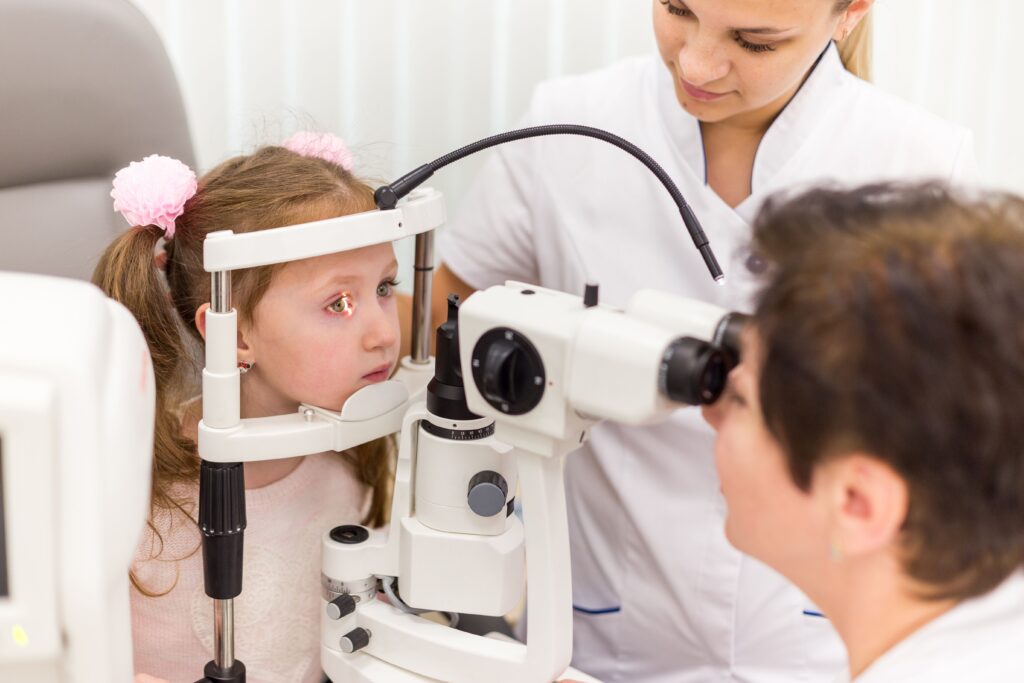
It is anticipated that the global ophthalmic diagnostic equipment industry demand will offer an opulent growth opportunity, rising at a CAGR of 6.7% from a valuation of US$ 3.0 billion in 2022 to US$ 5.1 billion by 2030. The global ophthalmic diagnostic equipment industry is a vital segment within the broader medical devices industry, specializing in the diagnosis and evaluation of various eye conditions and diseases. This market plays a crucial role in maintaining eye health and preventing vision impairment through early detection and accurate diagnoses. Ophthalmic diagnostic equipment encompasses a diverse range of devices, including fundus cameras, tonometers, optical coherence tomography (OCT) machines, slit lamps, and autorefractors, among others. Gain Your demo Report Featuring The Latest Market Research: https://www.futuremarketinsights.com/reports/sample/rep-gb-771 The market for ophthalmic diagnostic equipment has experienced significant growth in recent years due to factors such as an aging population, the rising prevalence of eye disorders like cataracts, glaucoma, and diabetic retinopathy, as well as an increased awareness of the importance of regular eye check-ups. Advancements in technology have also played a pivotal role in driving the market, leading to more precise and efficient diagnostic tools. Moreover, the integration of artificial intelligence (AI) and machine learning algorithms into ophthalmic diagnostic equipment has further enhanced its capabilities, allowing for automated detection and analysis of eye conditions with higher accuracy and speed. These AI-driven solutions enable early diagnosis, thereby enabling prompt intervention and treatment, ultimately improving patient outcomes. Geographically, the market has witnessed growth across various regions, with developed countries showing a high adoption rate of advanced diagnostic tools, while developing regions are experiencing a surge in demand due to improving healthcare infrastructure and increasing disposable income. Key Takeaways:
Innovative Strategies Unveiled: Customization at the Core of Our Report: https://www.futuremarketinsights.com/customization-available/rep-gb-771 Competitive Landscape: TOPCON CORPORATION, ZEISS International, Ellex, Quantel Medical, NIDEK CO., LTD., HAAG-STREIT GROUP, Halma plc, Coburn Technologies Inc., Kowa Company Ltd. are some of the key companies profiled in the full version of the report. Major competitors in the ophthalmic diagnostic equipment market are concentrating their efforts on expanding their worldwide and regional footprints through strategic acquisitions and mergers, as well as operational growth. Companies in the ophthalmic diagnostic equipment market are following new product innovations and launches, regulatory approvals, and acquisitions as the key strategies. Key players are focusing on the development of advanced and cost-effective products and establishing distribution agreements to increase geographic reach, especially in the Asia Pacific region. Moreover, companies are targeting Asia region by establishing manufacturing units in order to reduce manufacturing costs. More Insights into Ophthalmic Diagnostic Equipment Market: The United States is anticipated to rule the ophthalmic diagnostic equipment market accounting for over 89.2% of the North American region. Owing to the increased prevalence of refractive error disorders, the increased number of eye condition awareness programs, and the increased use of superior diagnostic technology are all contributing to this increase. Germany accounted for approximately 28.6% of the Western Europe market in 2021. According to Eurostat one of the most common surgical procedures in Europe is cataract surgery. The rising number of cataract operations has had a significant influence on the ophthalmic industry, resulting in increased demand for cataract surgery equipment and medications. China accounted for about 40.4% of the APEJ region in 2021. Factors such as the increasing number of people belonging to the older population that suffer primarily from poor eyesight and other eye-related diseases such as glaucoma and cataract contributed to market growth in this region. India accounted for a 13.1% market share of APEJ in 2021 and is expected to show a similar trend in the coming years also. In India, ophthalmology-related disorders are on the rise. In India, almost 5 million cataract procedures are conducted every year. The bulk of these operations includes the implantation of intraocular lenses. Our Analyst Is Here To Assist You With Any Questions Get In Touch Now! https://www.futuremarketinsights.com/ask-question/rep-gb-771 Ophthalmic Diagnostic Equipment Market by Category: By Product:
By End user:
About Future Market Insights (FMI) Future Market Insights, Inc. (ESOMAR certified, recipient of the Stevie Award, and a member of the Greater New York Chamber of Commerce) offers profound insights into the driving factors that are boosting demand in the market. FMI stands as the leading global provider of market intelligence, advisory services, consulting, and events for the Packaging, Food and Beverage, Consumer Technology, Healthcare, Industrial, and Chemicals markets. With a vast team of over 5000 analysts worldwide, FMI provides global, regional, and local expertise on diverse domains and industry trends across more than 110 countries. Contact Us:¬†¬†¬†¬†¬†¬†¬†¬† Nandini Singh Sawlani¬†¬†¬† Future Market Insights Inc.  Housing a World Health Organization Collaborating Centre, Shandong First Medical University (SDFMU) has quickly become a leader in disease research and treatment. With innovative approaches to skin, parasitic, and rare diseases, it sets standards in many prevention and control methods. Making huge steps in the early diagnosis and treatment of tumours, and radiation protection, the university is looking to spread its successful experience to developing countries in Africa and Asia, broadly benefiting human health. The 2019 merger of Taishan Medical University, Shandong Academy of Medical Sciences, and several local hospitals in Shandong saw the establishment of SDFMU. With the main campus in the historic and cultural city of Jinan, capital of Shandong province, the university aims to make a big impact on higher medical education in Shandong and the nation. By integrating quality research, education, and clinical resources, it seeks to build a novel training system for innovative medical personnel, and become a first-class applied research university. ‚ÄúWe strive to build the largest medical research centre in the province within five years, and be ranked among the nation‚Äôs top 10 medical universities within 10 years, with some world-class academic programmes,‚ÄĚ said Guang Ning, the president of SDFMU. ‚ÄúIn line with the ‚ÄėHealthy China‚Äô strategy, and the provincial strategy to integrate science and education, we want to become a model site for science-education integration, industry-university-research partnerships, and for system innovation.‚ÄĚ Medical research and disease prevention Focusing on cutting-edge research in medicine and life sciences, SDFMU researchers are engaged in basic and applied research, targeting major diseases that threaten human health. The university has strong foundations in ophthalmic keratopathy, endocrine and metabolic diseases, leprosy, and tumour radiotherapy. Housing a number of advanced research platforms, including ministerial and provincial key laboratories, it has achieved innovative research results, bringing significant social and economic benefits. Researchers from Shandong were pioneer in eliminating four infectious diseases that were major health threats in China in the last century, including leishmaniasis, filariasis, malaria, and leprosy. The work on these four diseases was lauded as by the World Health Organization (WHO). Clinical service With four general hospitals and five specialty hospitals, SDFMU has strong clinical service capacity. One of its general hospitals is ranked 16th in comprehensive strengths among hospitals of East China in the best hospital ranking produced by Fudan University. Two specialty hospitals were listed among the national top 10 in terms of Fudan‚Äôs ranking for reputation of clinical specialties. With the construction of the Proton Therapy Center at Shandong Cancer Hospital well underway, the university is to further enhance its research, teaching, and residency training capacities. Talent training As a pilot site for a national training programme of outstanding physicians, SDFMU has a strong clinical medicine programme, ranking among the global top 1% according to the Essential Science Indicators ranking. With a focus on medical sciences, the university has set up diverse programmes covering humanities, law, natural science and engineering, management, and education, featuring 44 undergraduate programmes. With talent cultivation as a core mission, the university has established a comprehensive, multilevel training system. Its main campus in Jinan employs an elite education model, aiming to produce medical talents with solid academic backgrounds, superb medical skills, an innovative spirit, and a global vision. Its people are capable of leading future medical development, through joint training with renowned global universities. The Tai‚Äôan campus emphasizes specialty education, focusing on cultivating talents with strong applied skills to meet local demand for medical services, and for professionals in fields short of capacity. Great efforts are made to enhance strengths, and develop medical technology and nutrition and health related subjects by encouraging deep integration of medical science with other disciplines, with the goal to make the university a key base providing much needed skillful medical professionals for Shandong. International cooperation Internationalization is part of the university development strategy, leading to partnerships with universities and medical institutions in 30-plus countries, such as Britain, the United States and Australia. In the past five years, the university has carried out more than 100 international cooperation projects, including those under the China-UK Global Health Support Programme, sponsored by the Ministry of Commerce, and the National Key Research and Development Plan of the Ministry of Science and Technology (MOST). Since 2004, it has enrolled undergraduate and graduate international students from more than 20 countries and regions. It has also organized several training classes on prevention and treatment of common infectious diseases in developing countries, part of a MOST programme. 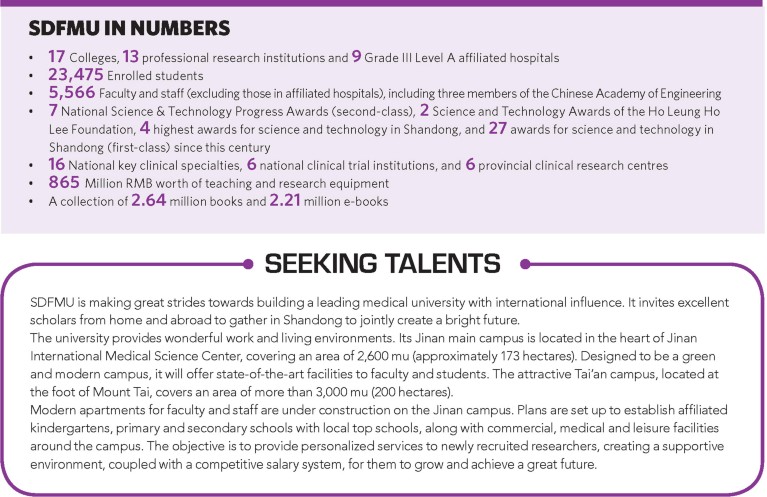 Basic medical science refers to the graduation degree in medicine. It is the basic medical degree where you gain basic expertise in both medicine and surgery. In India, this degree in known as MBBS (Medicinae Baccalaureus and Bachelor of Surgery). When you have a degree in basic medical science, you are eligible to practice medicine anywhere. Commonly known as doctors or physicians, you perform the tasks which fall broadly under the purview of family medicine. Doctors with a degree in basic medical sciences are not specialists in any particular area of the body or any particular ailment. Instead, they look after the overall health of the patient and provide a complete care advice. They are the first medical professional a layperson visits in case of any physical distress. They prescribe the proper medicine and treatment and are also the point from where all referrals to the specialists originate. A person qualified in basic medical science can perform all basic medical tasks ranging from diagnosis, treatment, follow-up, injections, labor and delivery and also refers the patient to specialists as and when required. Courses categorized under Basic Medical SciencesCareer options in basic medical scienceWith a degree in basic medical science, you have the following career options:
Approximate salary at the entry levelThe entry level salary varies markedly depending on a number of factors. You are unlikely to earn as high as a specialist, but still there is ample scope, especially in rural areas. If you are service minded, there is also huge satisfaction in this profession. Pre qualifications required for the courseIn order to study basic medical sciences, you will have to cross the following stages:
Best places in India to study the courseThe top institutes of India where you can study basic medical sciences are as follows:
Best places in the world to study the courseThe leading institutes of the world where you can study basic medical science are as follows:
Image courtesy of Dannette Casper There is a lot to learn if you are making a career transition into or entering the medical packaging field. Thankfully, the Medical Device Packaging Technical Committee (MDPTC) of the Institute of Packaging Professionals is here to help. This committee invested in developing Fundamentals of Medical Device Packaging to enable rapid learning about medical device packaging. The course was first offered at Pack Expo International 2022 and featured classroom and expo floor instruction.
If you are considering the course, listen in as five medical device packaging leaders debriefed the merits of this course in a SPOT Radio podcast, by Charlie Webb, Founder and President of Van der Stahl Scientific and CPPL (‚Äúlifetime‚ÄĚ Certified Packaging Professional).SPOT stands for Sterile Packaging on Track. The five leaders interviewed are myself, Dannette Casper, Package Engineer, Edward LifeSciences; Sarah Rosenblum, Senior Director of Sales & Marketing, and Cassandra Ladd,¬†Senior Marketing Manager, both at Packaging Compliance Labs; Art Castronovo, Director Package Engineering and Product Labeling at Johnson and Johnson; and Jennifer Benolken, MDM & Regulatory Specialist, Packaging Engineering, DuPont Tyvek, Healthcare Packaging. Highlights of their conversation include: 1. Synopsis of the new Medical Device Packaging Fundamental‚Äôs class, which covers all the steps/functions of packaging a medical device, from design to launch. 2. Review of the premier offering at Pack Expo. It was sold out! And attendees were highly engaged. Their peer-to-peer participation added to the richness of the content presented by the experts. 3. Expectations for the second Medical Device Packaging Fundamental‚Äôs class at MD&M West¬†in Anaheim, Calif., The show runs from February 7-9, but the Fundamental‚Äôs class starts on the afternoon of February 6 and runs until February 8. Registration is now open for this second class and you can sign up here. MD&M West is co-located with WestPack. ¬† Sign up for the QMED & MD+DI Daily newsletter. Not everyone with a substance use problem requires medical detox before entering a drug rehabilitation program, but those who have a physical dependency on a drug, or who would be risking their health to attempt to quit on their own, may benefit from beginning their addiction treatment with it. While detoxification helps to eliminate the physical symptoms of addiction, most patients will need additional medical and psychological assistance. Quitting a substance doesn‚Äôt address the underlying causes of the initial addiction, which could be genetic, environmental, or behavioral. Also, there may be changes in brain chemistry as a result of long-term substance abuse that need to be addressed. Recovery usually involves treating the patient's mind as well as their body. Data coverage: Data encompasses B2B, B2G, and B2C spend. Figures are based on medical devices and IVD revenues allocated to the country where the money is spent at manufacturer price levels excluding VAT.Modeling approach / Market size: Modeling employs a top-down approach with a bottom-up validation, using financial information of the key players by market. Market sizes are determined by a top-down approach, based on a specific rationale for each market market and allocated to the covered countries according to the global market shares. As a basis for evaluating markets, we use relevant key market indicators and data from country-specific associations, such as healthcare expenditure per capita, health risk factors, healthcare system, and regulations concerning medical products. Next, we use further relevant key market indicators and data from country-specific associations, such as healthcare expenditure per capita, health risk factors, healthcare payer system, and regulations concerning medical products. This data helps us estimate the market size for each country individually.Forecasts: In our forecasts, we apply diverse forecasting techniques. The selection of forecasting techniques is based on the behavior of the particular market. For example, forecasts are based on historical developments, current trends, and key market indicators.Additional notes: Data is modeled in US$ using current exchange rates. The market is updated twice per year in case market dynamics change. The impact of the COVID-19 pandemic is considered at a country-specific level.Data coverage: Data encompasses B2B, B2G, and B2C spend. Figures are based on medical devices and IVD revenues allocated to the country where the money is spent at manufacturer price levels excluding VAT.Modeling approach / Market size: Modeling employs a top-down approach with a bottom-up validation, using financial information of the key players by market. Market sizes are determined by a top-down approach, based on a specific rationale for each market market and allocated to the covered countries according to the global market shares. As a basis for evaluating markets, we use relevant key market indicators and data from country-specific associations, such as healthcare expenditure per capita, health risk factors, healthcare system, and regulations concerning medical products. Next, we use further relevant key market indicators and data from country-specific associations, such as healthcare expenditure per capita, health risk factors, healthcare payer system, and regulations concerning medical products. This data helps us estimate the market size for each country individually.Forecasts: In our forecasts, we apply diverse forecasting techniques. The selection of forecasting techniques is based on the behavior of the particular market. For example, forecasts are based on historical developments, current trends, and key market indicators.Additional notes: Data is modeled in US$ using current exchange rates. The market is updated twice per year in case market dynamics change. The impact of the COVID-19 pandemic is considered at a country-specific level. | ||||||||
OCS resources | OCS basics | OCS education | OCS learning | OCS exam Questions | OCS exam Questions | OCS questions | OCS information source | OCS Study Guide | OCS exam format | | ||||||||
Killexams exam Simulator Killexams Questions and Answers Killexams Exams List Search Exams |











